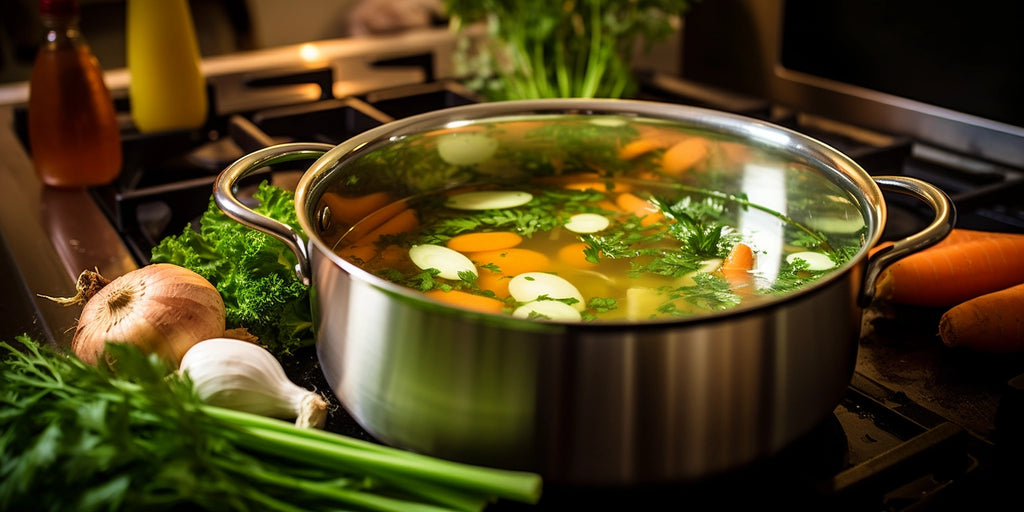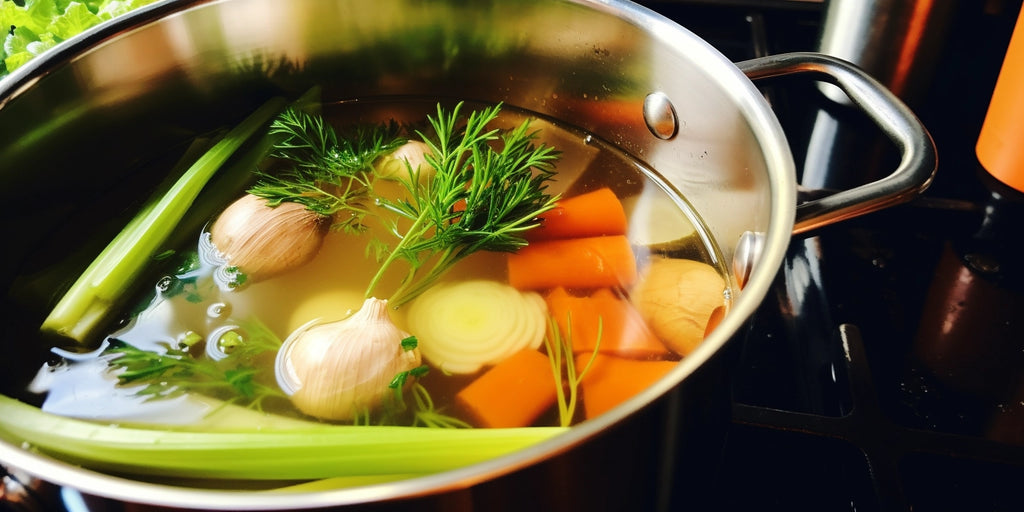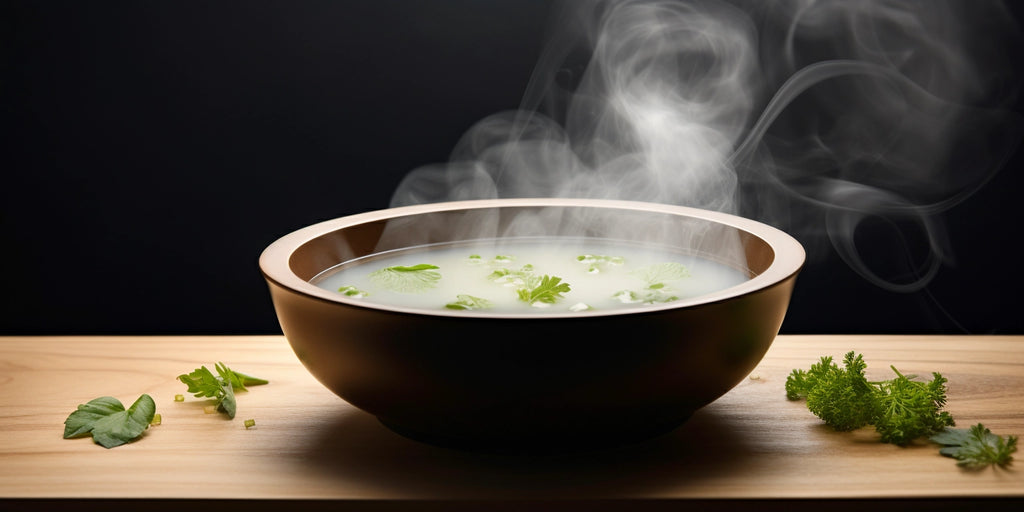When it comes to packing serious nutrition into a savory bowl of soup, nothing beats bone broth. It's not just about the rich flavors that dance on your palate, but also the healthful benefits that come with each spoonful.
The beauty of bone broth soup lies in its simplicity. Whether you're using the leftover bones from our Lemon Herb Roasted Chicken or opting for the best beef bone broth out there, you're on your way to creating a nutritional powerhouse.
But don't let the simplicity fool you. Bone broth soup is a canvas, ready to be painted with a medley of spices, herbs, and veggies. So, let's roll up our sleeves and dive into the world of bone broth soup.

Benefits of Bone Broth Soup
Recognizing the undeniable health benefits of bone broth soup will not only add depth to our appreciation for this classic comfort food but also give us further incentives to incorporate it efficiently into our diet. Bone broth soup offers wonderful health benefits that contribute to total wellness from promoting gut health to fortifying our immune system.
Promotes Gut Health
Bone broth soup has substantial gut health benefits, providing our bodies with the necessary nutrients to support digestion and gut health. Rich in vitamins, minerals, and amino acids like calcium and collagen, the soup forms a healing layer in the gut which aids digestion.
Besides, the soup is also packed with Vitamin A, an essential vitamin that is crucial for maintaining healthy gut function. It also includes other nutritional elements to support our gut health. If the soup is made using high-quality ingredients and homemade bone broth, we're adding a wholesome boost to our gut health.
Supports Joint Health
In addition to promoting gut health, bone broth soup also offers considerable benefits for joint health. Being a rich source of collagen, the soup provides necessary support to our joints. Collagen is a critical nutrient found in our joints, and increasing our intake through sources like bone broth soup helps maintain our joint health, tackling common issues like joint pain.
Moreover, bone broth soup contains other natural compounds like gelatin and glucosamine that also assist in supporting joint health. They're known for increasing joint flexibility, reducing pain, and promoting overall joint comfort.
Boosts Immune System
The third key benefit of bone broth soup is its ability to boost our immune system. Its high nutrient density, rich in vitamins and minerals, makes it an excellent immune booster. In particular, this hearty soup acts as a great immune booster when we're not at our best, perhaps during a bout of cold or flu. It effectively ensures that our body is supplied with the vital nutrients that our immune system needs to function optimally.
Moreover, the amino acids in the soup have been tied to improving our immune function and supporting our bodies in managing stress. Therefore, bone broth soup is a fantastic, easy way to bolster our immune system whether you're feeling under the weather or just aiming for proactive wellness.
As we've seen, bone broth isn't just tasty and easy to make, it's also impressively rich in a variety of essential nutrients. It's a humble yet powerful food that has the ability to support our gut health, joints, and immune system all at once. It can easily be turned into delicious soups or stews for a wholesome, healthy main dish for any night of the week.

How to Make Bone Broth Soup
Bone broth soup is a nutritious, versatile food option that not only is full of beneficial nutrients but also flexible and adaptable to spices, herbs, and veggies of your preference. Let's dive right into how we can prepare this nourishing soup.
Ingredients Needed
Your bone broth soup will reach new heights of flavor with a few simple ingredients. Here is the list of ingredients you'll need:
- Bone Broth: You can use either chicken or beef bone broth, but for our recipe, we'll use 2 pounds of beef bones.
- Vegetables: 2 thickly sliced onions, 2 carrots and 3 cloves of crushed garlic will add depth to the flavor.
- Additional Ingredients: Apart from the bones and the vegetables, we'll also need some other things like a 6-ounce can of tomato paste, 2 bay leaves, 6 cups of cool water, and cooking spray.
Cooking Instructions
Preparing bone broth soup might seem like a lengthy process, but we assure you, it's worth every minute. The luscious flavors that come from hours of simmering are unparalleled. Here are the easy-to-follow cooking steps:
- Preheat your oven to 400°F (200°C). Spray a roasting pan with the cooking spray.
- Spread tomato paste on the beef bones and place them in the prepared roasting pan.
- Bake them until the bones have browned, typically taking about 30 minutes.
- Then, transfer the bones to a slow cooker and pour in enough water to cover the bones entirely. Add the onions, carrots, garlic, and bay leaves to the broth mixture.
- Cook on low for a minimum of 24 hours to extract maximum flavor and nutrients.
- After 24 hours, strain the broth through a fine-mesh strainer into a container and let it cool.
Tips for Flavor Enhancement
Now that we've prepared a flavorful bone broth, let's talk about enhancing it even further. While the soup is very flavorful thanks to the bone broth, feel free to add in extra ingredients. Adding fresh or frozen cauliflower rice, for instance, provides an extra layer of texture without compromising on the natural flavor. Similarly, using fresh rosemary adds another layer of tang, and a squeeze of lemon at the end brightens the whole dish. Customize your bone broth soup to your preference and enjoy this nourishing meal in every bite.
Serving suggestions
How you plan to use your bone broth soup often determines your serving choices. If you're looking for restorative and medicinal benefits, it's a common choice to sip it warm with a sprinkle of sea salt and cracked pepper. But if sipping isn't quite your style, we have other suggestions too.
You can employ your bone broth in the same fashion as regular meat stocks or broths. It makes a fantastic base for various soups and stews. Consider, for instance, using it in dishes like bok choy soup, Vietnamese pho, wild rice soup, and beef stew.
Looking to spruce up your grains? We got your cover there too. Swapping water for bone broth while cooking rice and grains like brown rice, risotto, wild rice, farro, lentils, and quinoa is an effortless means to introduce extra flavor and protein into your meals.
Apart from these, bone broth serves as a key ingredient in preparing superb sauces. It can take your gravy, roux, pan sauces, or reductions to the next level. And if you're feeling adventurous, why not try it in other recipes like jambalaya, beef stroganoff, or tater tot casserole?
The beauty of bone broth soup lies in its versatility. Regardless of whether it takes the spotlight or plays a supporting role, it enhances the flavors and nutritional value of your dish. No matter how you choose to enjoy it, the bone broth invites room for creativity, allowing you to tailor the taste to your preference. The journey of exploring the various culinary uses of bone broth soup is as exciting as the process of making it. Remember, there are no hard and fast rules - feel free to experiment and discover your own favorite ways to incorporate it in your meals.
Variations of Bone Broth Soup
There are countless ways to enjoy the goodness of bone broth soup. Let's delve into some variations that you can try according to your taste and dietary preferences.
Chicken Bone Broth Soup
A top choice among bone broth enthusiasts, Chicken Bone Broth Soup, is a classic. It's packed with boneless, skinless chicken meat and immune-boosting vegetables like carrots, onions, and celery. It's as flavorful as it is nourishing, perfect at any time of the year, but particularly helpful during the cold season.
You can add cooked rice or noodles into the mix, or if you follow diets like paleo or keto – simply enjoy it as it is. And if you can't get your chicken soup flavors exactly right, please try switching to bone broth as it adds a depth of flavor that plain water or stock can fail to deliver.
Beef Bone Broth Soup
Next up is Beef Bone Broth Soup which is a great option for the meat lovers among us. With quality beef bone broth, a little creativity and seasoning, the result is a robust, savory soup. To let the beef shine, keep the additions simple — tender veggies, herbs, and a handful of spices do the trick. Additionally, bone broth is known for its rich nutritional value. This soup isn't just about satisfying cravings – it's about nourishing your body too.
Vegetable Bone Broth Soup
Last but not least, Vegetable Bone Broth Soup is a great way to eat your greens while getting the healing benefits of bone broth. And it's not just limited to one kind of vegetable - you can be as adventurous as you like!
Cooking vegetables in bone broth not only softens them but also infuses them with additional nutrients and flavor, making your vegetable soup healthier and more enjoyable. Even leftovers can be transformed into a delightful bowl of soup. A single carrot, a bit of leftover roast chicken - all can be repurposed beautifully with a base of bone broth. With some garlic or ginger, herbs and spices – your vegetable bone broth soup will be far from ordinary.
Remember that the beauty of making bone broth soup is that it's forgiving. You can adjust the ingredients according to your preference, seasonality, and availability. Use these recipes as your guide and have fun experimenting.

Bone Broth Soup Recipes
We've delved into the flavorful world of bone broth soup, highlighting its versatility and the nutritional powerhouse it can be. We've explored how Chicken, Beef, and Vegetable Bone Broth Soups each bring unique flavors and health benefits to the table. We've also shared ways to enhance their taste by using different ingredients and seasonings.
So, whether you're catering to specific dietary needs, looking for a comforting meal, or just want to experiment with new flavors, bone broth soup is an excellent choice. It's flexible, forgiving, and always open to customization. Remember, the best bone broth soup recipe is the one that suits your palate and nutritional needs. So, don't be afraid to get creative and make it your own.
With bone broth soup, you're not just making a meal—you're crafting a nourishing experience. So go ahead, grab your ingredients, and let's start simmering!
Common Questions
Is bone broth soup good for you?
Bone broth soup is beneficial to your health. It's packed with nutrients such as collagen, electrolytes, and various amino acids. Regular consumption of bone broth soup can aid in reducing inflammation and muscle building, especially when combined with daily exercise.
Can you cook bone broth for too long?
Bone broth soup is typically simmered for an extended period, usually around 12 hours, to achieve a rich, flavorful result. However, it's not uncommon for it to be cooked for 24 or even 36 hours, enabling the nutrients and proteins from the bones to well infuse into the broth.
Should I drink bone broth in the morning or at night?
Having bone broth soup in the morning can stimulate your digestive system into action. It provides easily digestible and bioavailable essential nutrients, making it an excellent choice for improving gut health.
What is the downside of bone broth?
The major downside to consider with bone broth soup is its potential high sodium content. Some variants may contain up to 500 milligrams of sodium per cup, which could quickly accumulate.
How often should you drink bone broth soup?
To achieve the best results, it's recommended to consume bone broth soup daily. However, if that's not feasible due to budget limitations or lifestyle, strive to have it at least three times a week. If you have specific goals, like muscle building or enhancing gut health, you may need to drink more.







